Dates: 2019-2023
Project overview: Tuberculosis (TB) remains the world’s top infectious cause of death and a public health crisis in Southern Africa. Those who have worked in South Africa’s goldmines suffer TB rates amongst the highest worldwide, as both silica dust and silicosis (itself a chronic lung disease) increase vulnerability to TB. This burden is borne by black miners from South Africa and neighbouring countries whose rights were historically denied under racist colonial practices. Screening for TB and silicosis is needed to provide the hundreds of thousands of afflicted workers and their families with health services and social benefits to which they are entitled. A successful class action lawsuit further prompted improvements in access to compensation and social protection benefits, but there are insufficient trained health professionals willing and able to conduct the needed Benefit Medical Examinations.
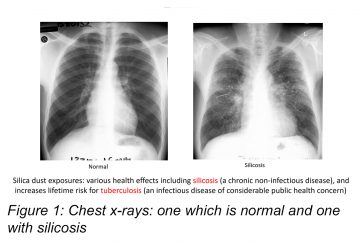 Computer-aided detection (CAD) systems are now well-developed to detect TB in chest x-rays (CXRs), but have never been validated in a population with a high burden of silicosis, which can mimic and mask TB (see Figures 1 and 2). Only recently are CAD systems being developed to detect silicosis; these too have never been evaluated in practice. This project is being undertaken by the GHRP in partnership with the agencies in South Africa
Computer-aided detection (CAD) systems are now well-developed to detect TB in chest x-rays (CXRs), but have never been validated in a population with a high burden of silicosis, which can mimic and mask TB (see Figures 1 and 2). Only recently are CAD systems being developed to detect silicosis; these too have never been evaluated in practice. This project is being undertaken by the GHRP in partnership with the agencies in South Africa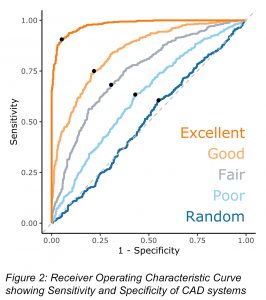 responsible for assessing miners and ex-miners and providing compensation services, the Medical Bureau for Occupational Disease (MBOD) and Compensation Commissioner for Occupational Disease (CCOD) – along with other interested parties including the association representing the ex-miners who are seeking social justice, the Southern African Miners Association (SAMA).
responsible for assessing miners and ex-miners and providing compensation services, the Medical Bureau for Occupational Disease (MBOD) and Compensation Commissioner for Occupational Disease (CCOD) – along with other interested parties including the association representing the ex-miners who are seeking social justice, the Southern African Miners Association (SAMA).
The History of the Project:
An initial CIHR Planning grant allowed synthesizing data and interviewing personnel involved in addressing TB and silicosis. We ascertained that radiologic assessment was a major source of delays in providing miners and their families with social benefits (Kistnasamy et al. 2018). This led us to prepare research to pursue a more expedient approach in line with technological advances, specifically exploring AI innovations.
Following a pilot study to identify technical issues relating to image quality and formatting, we identified that CAD of chest x-rays held promise to expedite access to health assessments and social benefits, once sufficient accuracy would be achieved for the detection or exclusion of TB and silicosis in this population; we found, however, that commercially available CAD was poor at distinguishing TB from silicosis (Young et al. 2020).
We also modeled how improvements could be made at the MBOD in its triage of claims (Barker et al. 2022); such changes were then made.
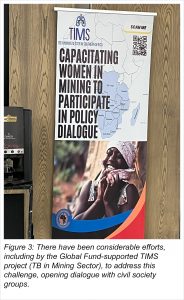 In conducting trials to assess the application of CAD in the field, we deepened our understanding of health equity concerns (Ehrlich et al. 2021, 2022, 2023; Williams et al. 2022), including issues arising from use of CAD and AI more generally, especially the need to overcome barriers that affect marginalized populations (Spiegel et al. 2021). This led to recognizing the critical value of strengthening local capacities for development and implementation in tune with local circumstances. As such, we decided to re-focus our research to carefully characterize what it would take to apply new techniques in machine training for both silicosis and TB to become part of a process of developing local capacity, sensitive to equity concerns (including for women as well as migrant and ill workers, and families of deceased ex-miners with only scanned films) (see Figure 3). To this end we are working with a team of computer science experts from the University of Witwatersrand.
In conducting trials to assess the application of CAD in the field, we deepened our understanding of health equity concerns (Ehrlich et al. 2021, 2022, 2023; Williams et al. 2022), including issues arising from use of CAD and AI more generally, especially the need to overcome barriers that affect marginalized populations (Spiegel et al. 2021). This led to recognizing the critical value of strengthening local capacities for development and implementation in tune with local circumstances. As such, we decided to re-focus our research to carefully characterize what it would take to apply new techniques in machine training for both silicosis and TB to become part of a process of developing local capacity, sensitive to equity concerns (including for women as well as migrant and ill workers, and families of deceased ex-miners with only scanned films) (see Figure 3). To this end we are working with a team of computer science experts from the University of Witwatersrand.
After various meetings with all parties (see Figure 4 for example) we held a face-to-face workshop in Johannesburg in November 2022 with ~60 invited participants; we presented the results of the work to-date and obtained input from all stakeholders on next steps (see Figure 5).
While addressing fairly complex technological scientific methodology, we were able to simplify our explanations such that all parties, including the representatives of the unions and ex-miners in South Africa, Mozambique, Malawi, Botswana, Lesotho and Eswatini were able to understand and participate fully (see PPT and Figure 6).
In June 2023, we conducted field visits in Lesotho and Eswatini, hosted by SAMA, and included meeting with local ex-miners and paying our respects to local chiefs (Figures 7 and 8), as well as meeting with various health providers, the National TB Control Programs, other government officials, and university personnel (Figure 9). Further implementation details were solidified and relationships with knowledge users further fortified.
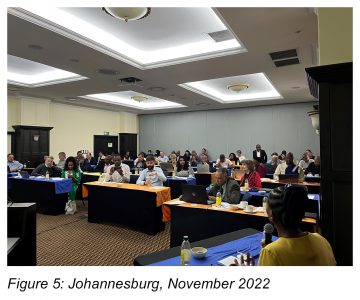
The funding we have had to accomplish the above:
– CIHR Planning Grant ($10,000; 2016–2017): Mitigating the Health Impacts of Injury among Former Mine Workers: Planning a collaborative international mixed methods study.
– World Health Organization ($80,000; 2020): TB in Migrant Mineworkers in Southern Africa: Developing CAD Systems to Improve Assessment of TB in Migrant Mineworkers.
– Medical Bureau for Occupational Diseases (MBOD) and Compensation Commissioner for Occupational Diseases (CCOD) ($40,000; 2021-2021): Artificial intelligence (AI) validation on x-ray for pneumoconiosis.
– UK’s Department for International Development, Frontier Technologies program ($150,000, 2019–2021): Tools to help diagnose ex-miners with tuberculosis and silicosis.
– South African Compensation Commissioner for Occupational Diseases ($35,000; 2021-2022): Artificial intelligence (AI) validation on chest x-ray for silicosis.
– South African Compensation Commissioner for Occupational Diseases ($65,000; 2022-2023): Improving efficiency in assessing occupational lung disease in SA ex-miners.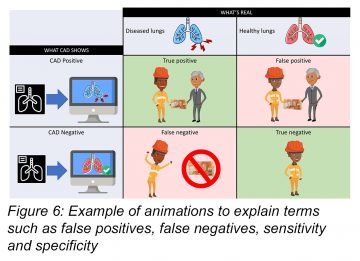
Publications:
Kistnasamy B, Yassi A, Yu J, et al. Tackling injustices of occupational lung disease acquired in South African mines: Recent developments and ongoing challenges. Globalization and Health. 2018;14(60). https://doi.org/10.1186/s12992-018-0376-3
Young C, Barker S, Ehrlich R, Kistnasamy B, Yassi A. Computer-aided detection for tuberculosis and silicosis in chest radiographs of gold miners of South Africa. International Journal of TB and Lung Diseases. 2020;24:444-451.
Ehrlich R, Barker S, Tsang VWL, Kistnasamy B, Yassi A. Access of migrant gold miners to compensation for occupational lung disease: quantifying a legacy of injustice. Journal of Migration & Health. 2021;4:100065.
Spiegel JM, Ehrlich R, Yassi A, Riera F, Wilkinson J, Lockhart K, Barker S, Kistnasamy B. Using Artificial Intelligence for High-Volume Identification of Silicosis and Tuberculosis: A Bio-Ethics Approach. Annals of Global Health. 2021; 87(1): 58, 1–12. https://doi.org/10.5334/aogh.3206
Williams H, Ehrlich R, Barker S, Kisting S, Zungu M, Yassi A. The Utility of Length of Mining Service and Latency in Predicting Silicosis among Claimants to a Compensation Trust. International Journal of Environmental Research and Public Health. 2022 Mar 17;19(6):3562.
Ehrlich R, Barker S, Rees D, Naidoo J, Kistnasamy B, te Water Naude J, Yassi A. Accuracy of computer aided detection of occupational lung disease: silicosis and pulmonary tuberculosis in ex-miners from the South African gold mines. International Journal of Environmental Research and Public Health. 2022 Sep 29;19(19):12402.
Barker S, Ehrlich R, Spiegel JM, Kistnasamy B, Riera F, Fourie A, Mtshali N, Rabada M, Lockhart K, Yassi A. Reforming the workers’ compensation process for occupational lung disease among miners in South Africa – an efficiency study of claims assessment. International Archives of Occupational and Environmental Health. 2022. 95(4): 825-833.
Ehrlich R, Barker S, Montgomery A, Lewis P, Yassi A, Kistnasamy B. Mining Migrant Worker Recruitment Policy and the Production of a Silicosis Epidemic in Late 20th-Century Southern Africa. Annals of Global Health. 2023; 89(1): 25, 1–12.

Presentations:
Yassi et al. presentation made to stakeholders: Improving efficiency of assessing (ex)miners for tuberculosis (TB) and silicosis: Innovations to promote social justice, on May 5, 2021 PowerPoint available here
Yassi et al. presentation from November 2022 available here.
and another presentation: Use of computer aided detection to support triage for efficiency at the MBOD, here
Other resources:
Dying for Gold – Award-winning documentary on the effects of gold mining in South Africa on black miners.
Trailer of movie: https://www.youtube.com/watch?v=SXM_K8WYWQE
If you are interested in a screening of the GHRP copy of this film, please contact GHRP with a request.
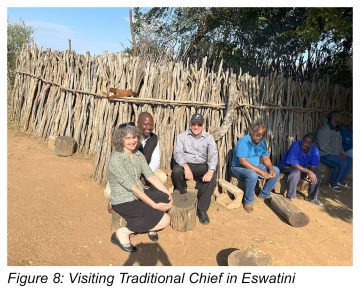
Articles in MEDIUM reporting on project progress:
AI4TB: Opportunities for improving systems to provide social benefits to those who incurred occupational lung disease
https://medium.com/frontier-technologies-hub/opportunities-for-improving-systems-to-provide-social-benefits-to-those-who-incurred-occupational-e78ea06395fa March 9, 2021
AI4TB: Ground-truthing machine-learning innovations
https://medium.com/frontier-technology-livestreaming/ai4tb-ground-truthing-machine-learning-innovations-10e87761ddf1 Sept. 16, 2020
AI4TB: Ground-truthing from machine-learning innovations
https://medium.com/frontier-technology-livestreaming/ai4tb-ground-truthing-machine-learning-innovations-5920d21d2177 April 9, 2020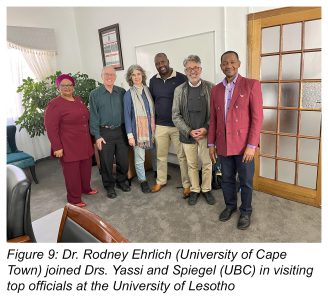
AI4TB: Moving forward on technical and decision-making challenges
https://medium.com/@jspiegel_88833/ai4tb-moving-forward-on-technical-and-decision-making-challenges-37519a6c2348 December 11, 2019
AI4TB: Can artificial intelligence systems be used to detect tuberculosis and silicosis among ex-miners in Southern Africa?
https://medium.com/frontier-technology-livestreaming/harnessing-artificial-intelligence-ai-systems-to-detect-tuberculosis-tb-among-ex-miners-in-551583112046 October 27, 2019